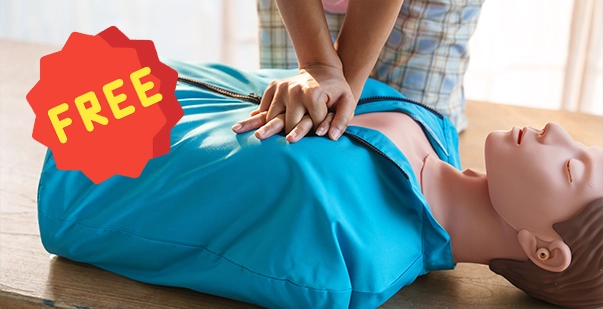
Last Updated on: November 8, 2024
Table of Contents:
Approximately 350,000 cardiac arrests occur outside of hospitals annually in the U.S. However, only 46% of those affected received immediate CPR from bystanders. The reason? Many bystanders simply don’t know how to perform CPR. Therefore, learning CPR doesn’t just benefit healthcare professionals; it is a skill that everyone should develop to act effectively during emergencies. However, when you don’t have the budget for certification courses, you should look for free CPR training online.
In this blog, we will discuss the most accessible and reliable options for obtaining CPR certification without paying, including both online and in-person options.
Cardiopulmonary Resuscitation (CPR) is a first aid technique performed in critical situations such as cardiac arrest or drowning. With timely CPR, oxygenated blood can be kept flowing to the brain and other vital organs, increasing a person’s chances of survival. Therefore, having CPR skills is invaluable. These are ideal for healthcare workers, teachers, or concerned individuals. While many CPR courses come at a cost, there are several ways to get free CPR classes online:
Your local health department is an excellent resource for free or low-cost CPR training. Many health departments provide community CPR classes, often sponsored by public health initiatives. The primary goal of these programs is to equip as many people as possible with life-saving skills, so fees are often waived for community members.
Local governments may prioritize first responders. They also extend training to the general public.
Several nonprofit organizations offer courses about CPR online for free. While some charge for certification, many also hold free CPR online workshops. These courses provide quality training, usually conducted by certified professionals, and are part of public safety initiatives or community events. The common ways through which nonprofit organizations can help you gain necessary CPR skills for free are as follows:
Many employers prioritize workplace safety and provide free CPR training to employees. This is particularly common in industries where quick emergency responses may be needed, such as healthcare, childcare, hospitality, and construction. Workplace CPR training programs can range from short workshops to comprehensive certification courses. To learn more about such programs, you can follow this approach:
Schools, universities, and community colleges often host discounted or free CPR and first aid classes for their students, staff, and sometimes even the public. Many educational institutions view CPR as a vital skill. This is especially true in physical education programs, healthcare-related majors, and courses designed for aspiring educators.
While in-person training is the most hands-on way to learn CPR, online resources provide convenient and free training options. They allow you to learn at your own pace. In addition, some websites offer online free CPR courses, providing video tutorials, demonstrations, and step-by-step guides.
Another great way to get free CPR training is by attending community health fairs and public safety events. These events often feature free CPR demonstrations and short courses aimed at educating the general public.
Some organizations will offer free first aid lessons and also set up booths with certified trainers. These trainers will walk attendees through the steps of CPR and give them a chance to practice on mannequins.
Public libraries and community centers frequently host educational events for their communities, including free CPR training. These venues often collaborate with local health departments, fire departments, or nonprofits to provide CPR classes as part of their public service programs.
Read More: Types of CPR Classes & Their Costs
CPR is a life-saving skill, and there are numerous free CPR training alternatives available. You can find high-quality CPR and first aid courses offered by local health departments, nonprofits, employers, or reputable online platforms. Taking these courses not only equips you with the knowledge to act in an emergency but also instills the confidence to save lives potentially.
Don’t wait for a crisis to learn – take advantage of the free training options available now and be prepared to step in and save a life when every second counts.
Read More: Difference Between CPR and First Aid